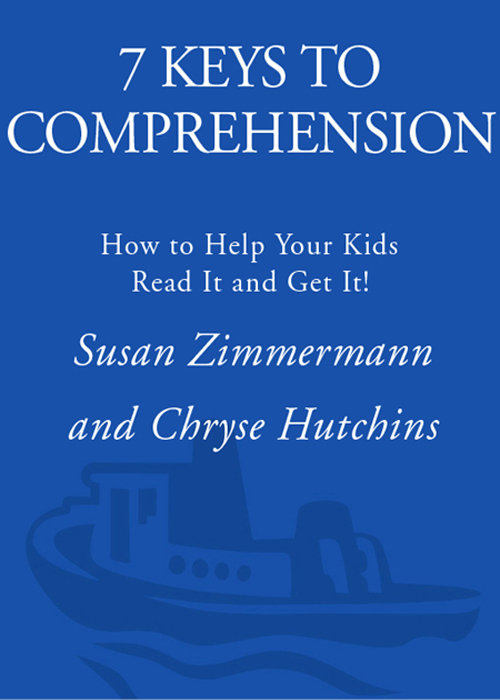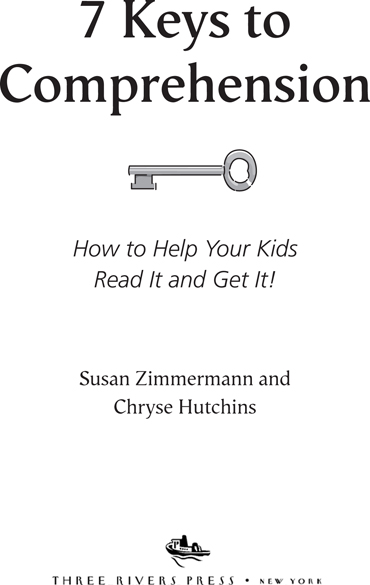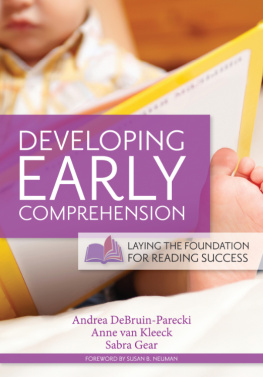

Contents
CHAPTER 2 Motion Picture of the Mind
Key 1: Sensory Images
CHAPTER 3 Making Connections
Key 2: Background Knowledge
CHAPTER 4 Why, What, Where, Who, and How
Key 3: Questioning
CHAPTER 5 Weaving Sense into Words
Key 4: Drawing Inferences
CHAPTER 6 What's Important and Why
Key 5: Determining Importance
Key 6: Synthesizing
CHAPTER 7 Cultivating Awareness
Key 7: Fix-Up Strategies
To Paul, who always read to our children
and charmed them with his stories.
To Steve, with love and heartfelt thanks
for believing I had something to say.
Acknowledgments
T HERE IS AN old saying that if you find a turtle on top of a fence post, he probably didn't get there by himself. It took many years and the work of many committed, thoughtful teachers, staff developers, and children for us to be able to write 7 Keys to Comprehension. We are grateful to each and every teacher whose classroom we visited and worked in, the many students who shared their thinking and reading with us, and the folks at the Public Education and Business Coalition (PEBC) who have worked tirelessly to bring the thinking strategies to life in Colorado and the nation.
Special thanks go to Ellin Oliver Keene, who spearheaded the comprehension work at the PEBC. Her belief that all children are capable of brilliant thinking set the standard for the successful implementation of what the research said was essential to include in great literacy instruction.
We thank Cris Tovani for her encouraging words to write a book for parents so they could be included in the comprehension conversation. Cris's masterful ability to empower her high school students to think critically about what they read showed us how much could be done with students others had given up on.
Thanks also to Stephanie Harvey, who always raised the bar of our thinking, and to Anne Goudvis, whose thoughtful, intellectual approach made us probe deeper. Their conversations gave us insight into how the strategies help children access content-area reading.
We learned invaluable lessons from Debbie Miller, an extraordinary first-grade teacher who showed us how the 7 Keys unlock the thinking side of reading for her young students. Thanks for showing us all that is possible.
We thank all the PEBC lab teachers, who opened their classrooms to us again and again: To Leslie Blauman for showing us the incredible way her students respond to what they read. To Patrick Allen for demonstrating the power of comprehension instruction while children are reading. To Carrie Symons and Sue Kempton for their insight into the interconnected nature of reading and writing. To Barbara McCallister, Cheryl Zimmerman, Carole Quinby, Barb Smith, and Mario Giardiello for deepening our understanding of what works and how to do it.
Many thanks go out to the teachers in the Denver area and across the nation who invite Chryse to work with their students. Modeling comprehension lessons and hearing all the ways children think about what they read led to the creation of the classroom connection sections in this book. Holly Hargrove, Andrea Harris, Debbie Behnfield, Paula Bowers, Carol Calkin, Sharon Messinger, Peggy Jurgs, Margaret Wing, and a host of others willingly shared their students and their expertise, so that we could learn together about the power of comprehension instruction.
We are grateful for our colleagues at the PEBC. Executive Director Barb Volpe, Mariah Dixon, and Diane Sweeney make possible the structures supporting the ongoing investigation of this comprehension work. Lori Conrad, Director of Literacy Initiatives, always poses questions that extend our thinking; and Judy Hendricks keeps us informed and kept encouraging the writing of this book.
The encouragement and insight of PEBC staff developers Sam Bennett, Leanna Harris, Melissa Matthews, Ilana Spiegel, and Jennifer Shouse helped us realize the importance this information holds for parents. Kristin Venable reminded us of the power of listening as she modeled this talent with adults and children. Special thanks to Joy Hood, for her expertise not only as a principal who helped her elementary school implement comprehension instruction, but also for sharing how her grandson uses the 7 Keys to make sense of the world around him.
Thanks also to the remarkable teachers and staff developers who pioneered both reading and writing workshops in Colorado classrooms: The work and wisdom of Marjorie Larner, Liz Stedem, Laura Benson, Marjory Ulm, Fran Jenner, Bruce Morgan, and Colleen Buddy fostered the implementation of the these strategies so they could flourish in so many settings.
This work stands on the shoulders of great writing teachers who came to Denver in the early days of the PEBC, held workshops, and expanded our vision about how to write with and learn from children. We are forever grateful to Donald Graves, Shelley Harwayne, Georgia Heard, Ralph Fletcher, and Joanne Hindley for inspiring us and moving us deeper into the realm of thinking about what literacy really means.
It has been easy to be passionate about this work. We have seen classrooms transformed, children turned on to reading, and teachers reinvigorated about their profession. Excellent books have come out of the PEBC's Reading Project and, as a result, changes are being made throughout the country in classroom reading programs. Reading for meaning is taking its rightful place at the core in many, many schools.
Yet we have long believed that the missing link in the teaching of reading was the parents. Parents are in the ideal position to awaken in their children a deep and long-lasting love of reading. Many do; those who don't, can. Both of us are fortunate in that we've had perfect laboratories to test our thinking about what makes kids become passionate readers. Our own children, now grown or nearly out of high school, have been exemplary guinea pigs and have all become avid readers. Thank you Helen, Alice, Mark, Carl and Elizabeth for your patience, curiosity, and support. You all are the best! Loving thanks to Katherine, Susan's handicapped daughter, who inspired Susan to start the Public Education and Business Coalition and pick up her pen in the first place; and to Chryse's sisters, Sara Messersmith and Laura Copple, who cheered each phase of the writing of this book.
Without the commitment of Stephanie Higgs and Betsy Rapoport, 7 Keys would never have made its way to the incredibly capable hands of our editor, Jamie Miller, and project editor, Tara Joffe. Thank you all for believing in the importance of this book and its message.
Last, but certainly not least, Susan's husband, Paul Phillips, has been the ultimate sounding board and editor, reading every chapter numerous times, red pen in hand, recommending changes to clarify, clarify, clarify. Thank you, Paul, for everything. And Chryse's husband, Steve, provided encouraging words each step of the way. Write it downyou have so much to say. His nudges to keep going were invaluable.
Without all of you, we'd still be the turtle looking up longingly at that fence post. We are deeply grateful.
I Love the Look of Words
Popcorn leaps, popping from the floor
of a hot black skillet
and into my mouth.
Black words leap,
snapping from the white
page. Rushing into my eyes. Sliding
into my brain which gobbles them
the way my tongue and teeth
chomp the buttered popcorn.
Next page






